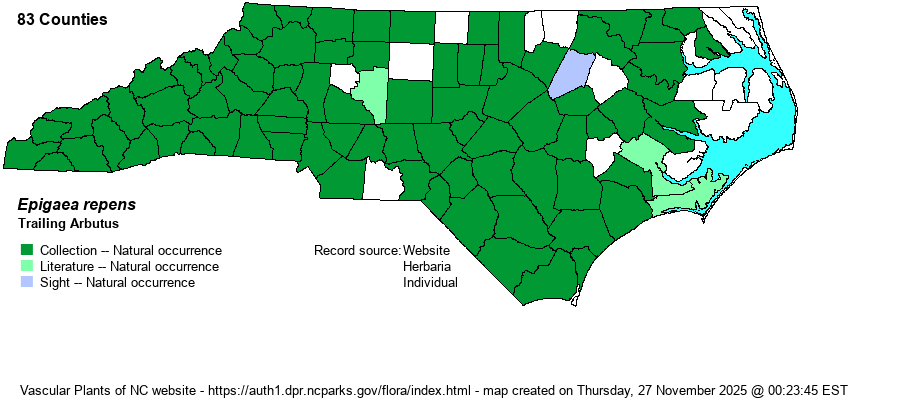| Author | L. | |
| Distribution | Occurs nearly statewide, though is apparently absent in some far eastern counties. For example, there appear to be no records as yet for coastal counties from the VA line south through Hyde County.
The species’ main range is north of the state, being widespread across southern Canada and south only to central GA and then southwest to the Gulf Coast in FL, AL, and MS.
| |
| Abundance | Common and easily found in the Mountains and foothills; fairly common or frequent farther eastward to the central Coastal Plain; scarce in the eastern Coastal Plain. | |
| Habitat | The species is found in many types of dry, acidic forests and forest openings. It is most common in somewhat rocky forests, especially near rhododendrons or Mountain Laurel (Kalmia latifolia). It also occurs in many sandhills sites, especially in dry sandy soils. It is more often seen on slopes (even on bluffs) than on flat ground. In some places it can be found in more mesic, loamy soils but always where the soil is quite acidic, often near or under other ericaceous shrubs. | |
| Phenology | One of our earliest blooming species, from late February downstate until April or early May in the higher mountains. Fruits from April to June. | |
| Identification | The species is easily recognized by the several broadly elliptic or somewhat rectangular, wavy-margined evergreen leaves (about 1.5 inches long) growing almost flat on the ground, though not quite as a basal rosette. The species does have a woody stem, and it is almost like a very short “vine”; but the general public might not perceive this woodiness and would consider it as an herbaceous species. The light pink flowers are very fragrant and can often be smelled before the plant is seen. Thankfully, all biologists and most of the public are familiar with this unique species, with its flowering often being a “harbinger of spring”. | |
| Taxonomic Comments | Essentially none, as the only other two species in the genus grow in Eurasia.
| |
| Other Common Name(s) | Mayflower, Ground Laurel. However, these other names are scarcely used, and Mayflower is in use for one or more other species. | |
| State Rank | S5 | |
| Global Rank | G5 | |
| State Status | | |
| US Status | | |
| USACE-agcp | | |
| USACE-emp | | |

